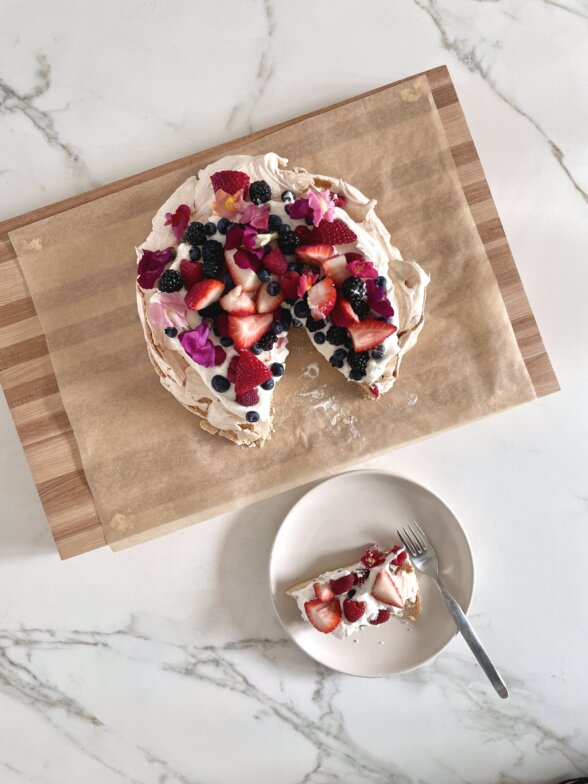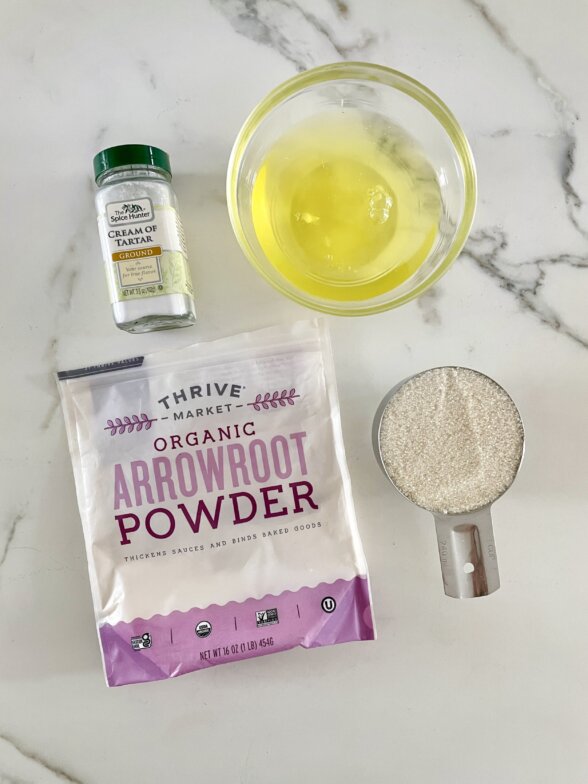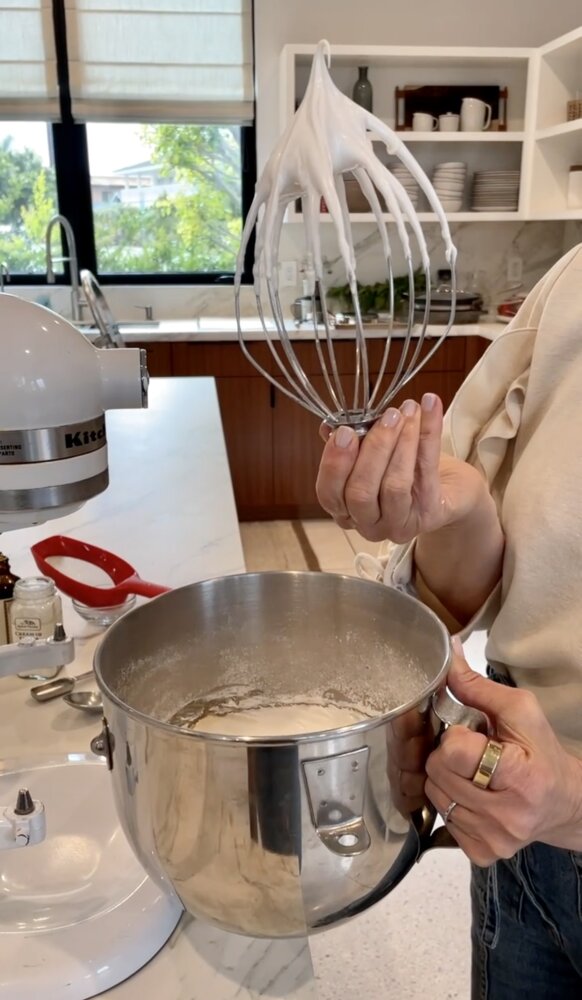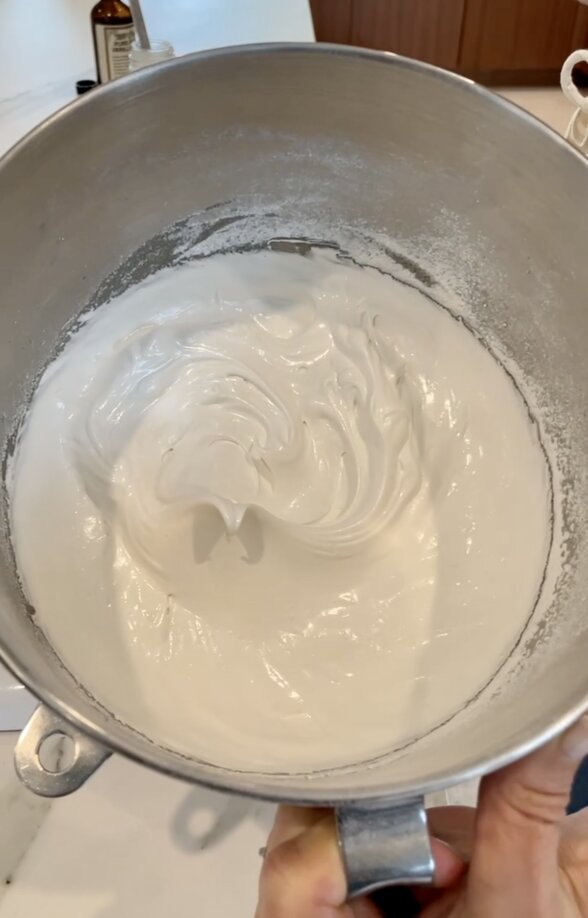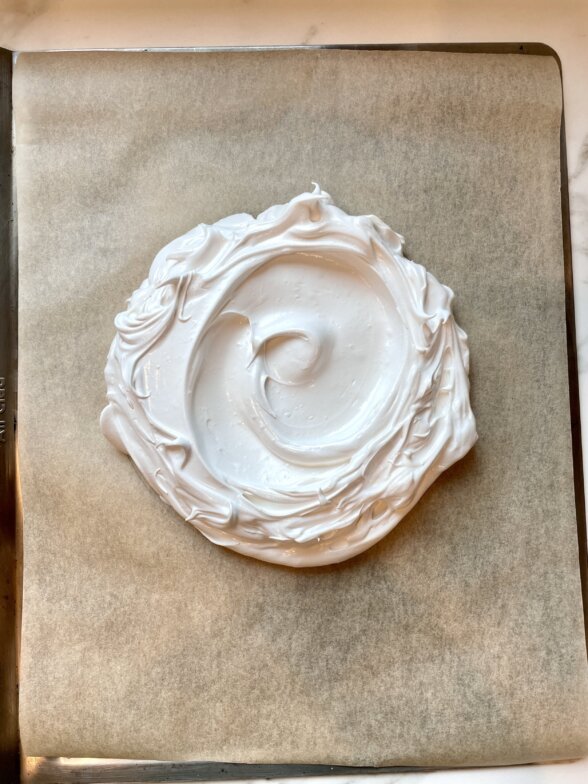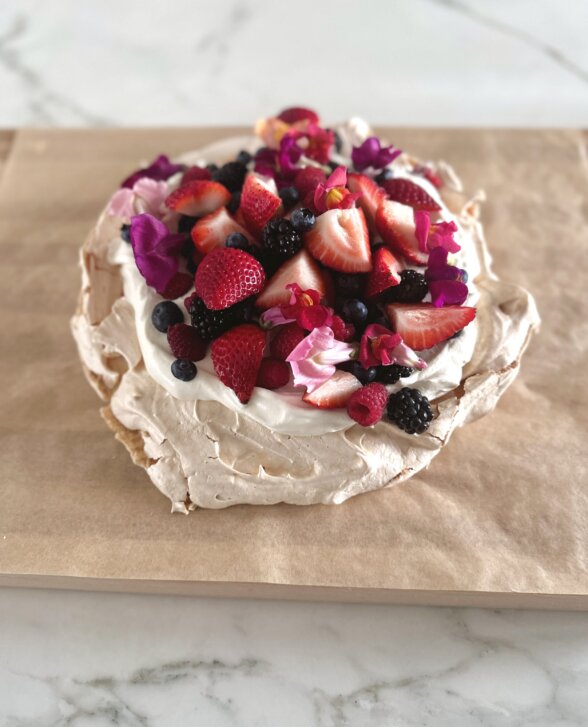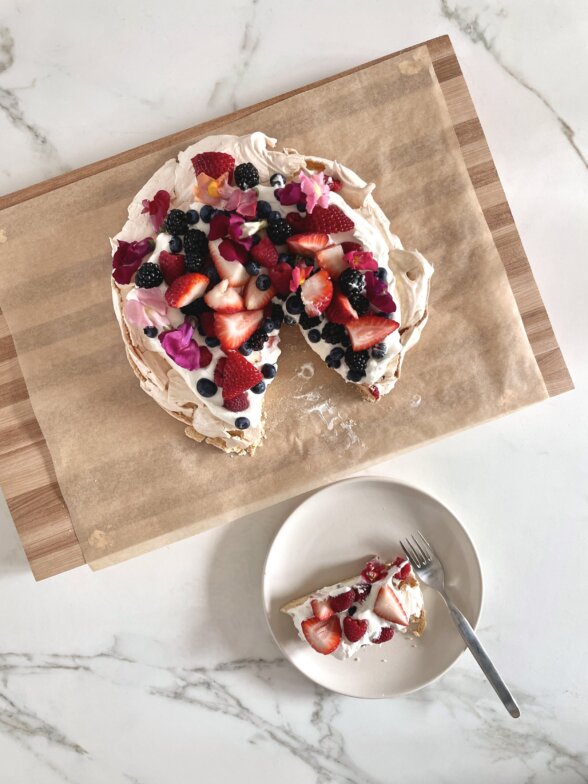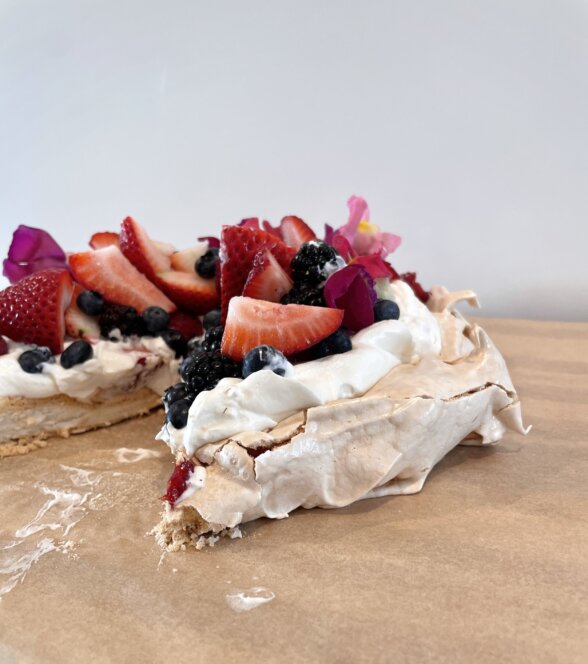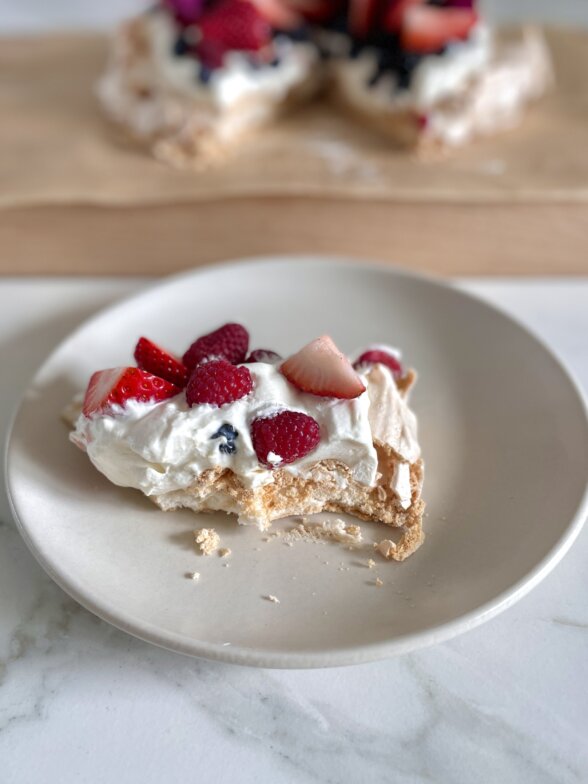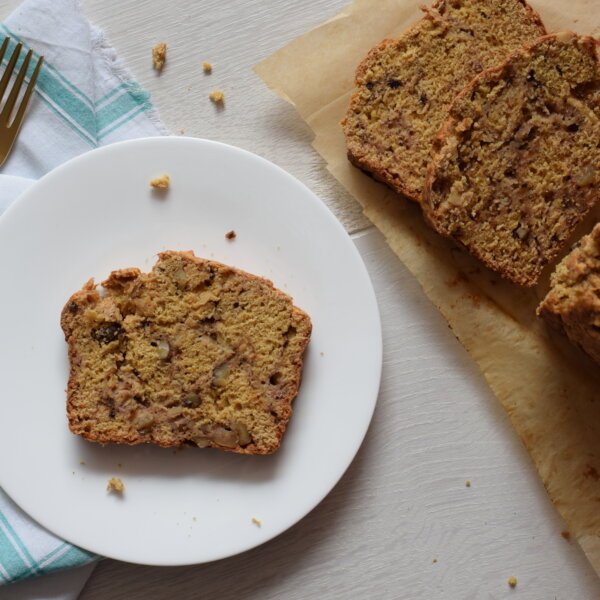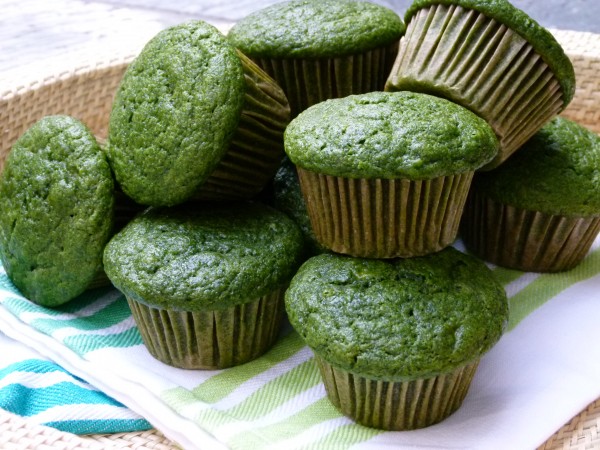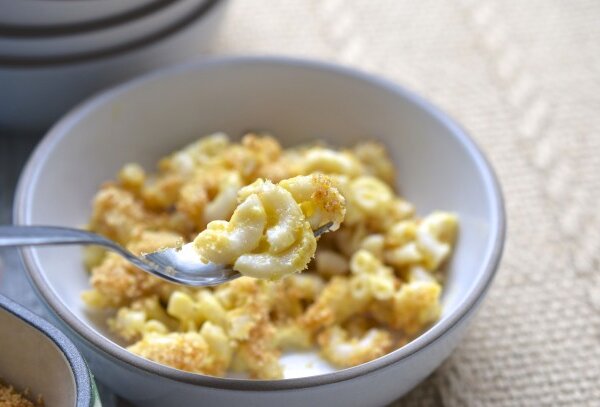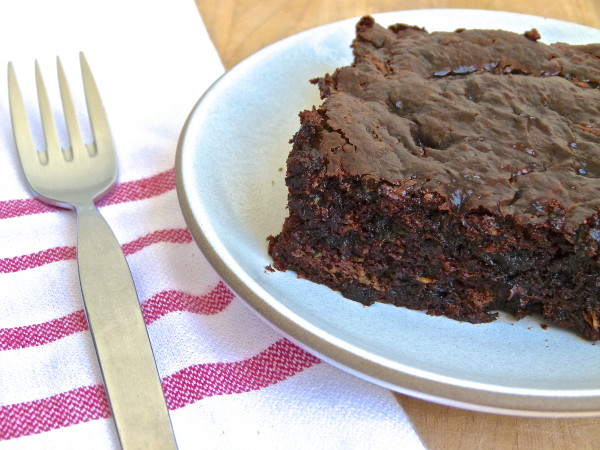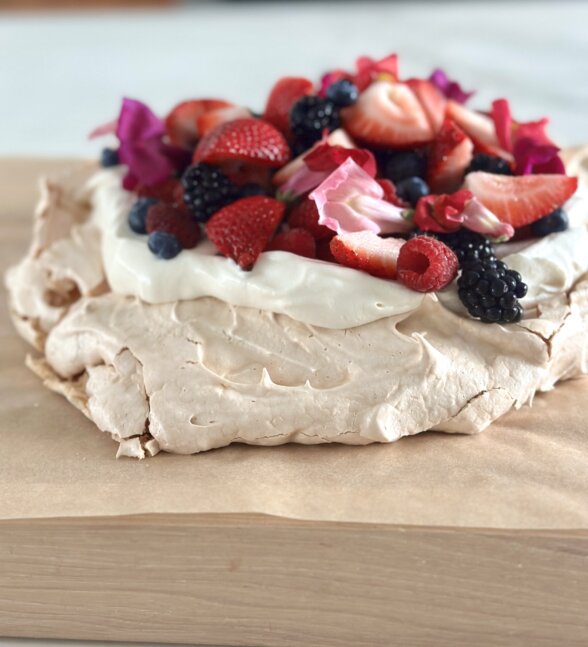
I love the drama of a Pavlova, which is a meringue cake that is crisp on the outside and soft and marshmallow-like on the inside. I did something a little different here which is to reduce to the sugar to as little as possible without the pavlova being a puddle of egg whites! Sugar provides structure for the egg whites, so I took it down as far as I could. Unfortunately, I would not recommend making meringue when the weather is humid. It just never really dries out properly. There are a lot of tips to ensure success with this recipe. Please read through at least once before commencing. I personally like topping the meringue with fresh seasonal fruit and anything not overly sweet. And you’ll notice I add a little Greek yogurt to my whipped cream for a little tang!
Why you’ll love this Pavlova recipe
- uses less sugar than other pavlova recipes;
- beautiful dessert for spring and summer;
- can be made ahead of time;
- you can make mini versions instead of a large one!
Ingredients
- Vinegar – you’ll need a small amount of vinegar (white distilled or apple cider vinegar) to wipe down the mixing bowl and beaters to remove any residual oil that could affect the pavlova.
- Egg whites – I use 4 large egg whites in this recipe. Save the egg yolks to make mug cakes (recipes in QTQ or on my Instagram page). You may be able to make this with aquafaba instead, but I haven’t tried it.
- Sugar – I reduced the sugar as much as possible in this recipe without compromising the final result. I do recommend using a fine sugar in this recipe. If you only have granulated sugar (like I do) you can pulverize it in a blender or spice grinder to make it finer.
- Arrowroot – is a starchy flour that performs similar to cornstarch, but more natural. I use it a lot to thicken up sauces or in grain-free baking.
- Cream of tartar – is a white powder that is used in meringues as a stabilizer.
- Vanilla extract – use pure vanilla extract without any additives or artificial flavors for best result.
- Heavy cream – I use heavy cream to make a whipped cream for the topping. You can use coconut cream instead or store bought Cocowhip.
- Greek yogurt – I prefer full-fat Greek yogurt. I add this to the whipped cream to thicken it up a bit.
- Berries – I like to use a mix of fresh berries, but you can use other fruits or top with a berry sauce.
How to make a Pavlova?
- Preheat the oven to 275°F or 250°F if your oven runs hot. Do not use convection. Line a baking sheet with unbleached parchment paper (it’s best to use parchment paper for this recipe as opposed to a silicone mat to remove any trace of residual oil that can affect the pavlova). Using a pencil or dark marker, draw an 8-inch diameter circle on the parchment paper by tracing around an 8-inch cake pan or plate. Flip the paper over so your meringue won’t touch the marker.
- Dampen a paper towel with a little vinegar and wipe the inside of a mixing bowl (metal, ceramic or glass – not plastic) and your beaters or whisk attachment to remove any trace of residual oil. Then wipe with a clean paper towel. Don’t worry about the vinegar smell, it won’t affect the final result.
- In the prepared bowl of your electric mixer fitted with the whisk attachment, beat the egg whites on medium speed until foamy, about 2 minutes. Raise the speed to medium-high and gradually add the sugar, 1 Tablespoon at a time. I like to count to 10 in between each addition. Continue beating until the meringue is glossy and stiff peaks form, 8-10 minutes. It should look like thick shaving cream.
- Sift in the arrowroot and cream of tartar (if you are using vinegar and/or vanilla, they go in now) and beat another minute until combined.
- Mound the meringue onto the parchment inside the circle. Using the spatula or a spoon, spread the meringue to fill the circle. Create a bit of a well in the center. That’s where the cream will go for serving. Place in the oven right away (no sitting out and waiting) and bake for 75 minutes at 275°F or 90 minutes at 250°F, or until the meringue is puffed and crisp all over, yet still not totally firm underneath if you touch the center. Do not open the oven door. Changes in temperature are bad for meringue. Cracks are totally normal and part of the charm. Turn off the oven, open the oven door a crack, like with a wooden spoon, and leave the meringue in the oven to cool to room temperature, at least 1 hour. I usually leave it overnight.
- Before serving, place a large bowl and the beaters of an electric mixer in the freezer. Carefully peel the meringue off of the parchment paper and place it on a serving platter.
- Prepare the whipped Greek yogurt and cream: Remove the mixing bowl and beaters from the freezer. Place the cream and yogurt in the bowl and beat on high speed. While the mixer is going, add the sugar and vanilla and beat until soft peaks form. Check the cream after 3 or 4 minutes and be sure not to overbeat.
- When you are ready to serve: Mound the whipped cream onto the meringue and gently spread it out about 1 inch from the edge (don’t worry if the meringue cracks in the process). Top the pavlova with the berry sauce and/or berries. Cut the pavlova into wedges, wiping the knife in between slices if necessary, and serve.
Tips
- If you don’t have superfine sugar, place the same amount of regular granulated sugar in a food processor or clean spice grinder and pulse until fine, about 30 seconds. This is the lowest amount I could take this recipe to. Less sugar does not allow the meringue to crisp up. You can go as high as 1 1/4 cups of sugar and your pavlova will be higher than mine.
- Dot the four corners of the sheet pan with a small amount of meringue to glue the parchment to the sheet pan so it stays in place and doesn’t move when you place the pavlova in the oven.
- Pavlova can be made ahead up to 1 day ahead and assembled right before serving.
- You can make 9-10 individual pavlovas instead of a large one. I would start checking after 20-25 minutes.
- If your oven runs hot: use the lower temperature in the recipe and I recommend leaving the oven door a crack open (with a wooden spoon) after you turn off the oven so the pavlova doesn’t get too dark.
Substitutions
- Eggs – 1/2 cup aquafaba (the liquid in a can of chickpeas)
- Arrowroot – cornstarch
- Heavy cream – try a whipped coconut cream or store-bought Cocowhip
Other recipes you may like
*Mixed Berry Fruit Cookie Pizza in Quicker than Quick
If you give this pavlova recipe a try, snap a pic and tag @pamelasalzman so I can see your beautiful creations. I also really appreciate readers taking the time to leave a rating and review! Subscribe for free to my site for the latest recipes, updates and things I’m loving lately. If you enjoy this recipe, I taught it last year in my online class! Give me an hour a month, and I’ll make you a better, healthier cook!
View this post on Instagram
Pavlova with Whipped Greek Yogurt and Cream and Berries
Ingredients
- FOR THE PAVLOVA
- Distilled white vinegar or apple cider vinegar for wiping the beaters and the mixing bowl
- 4 large egg whites, make sure not to get any yolk in them, at room temperature (do not use egg whites from a carton)
- ¾ cup + 2 Tablespoons superfine sugar*, ideally 1 cup if you don’t mind the extra sugar
- 2 teaspoons arrowroot or cornstarch or potato starch
- 1 teaspoon cream of tartar or 1 teaspoon white vinegar, apple cider vinegar, or lemon juice
- ½ teaspoon pure vanilla extract, optional
- FOR THE WHIPPED GREEK YOGURT AND CREAM
- 1 cup heavy cream, preferably not ultra-pasteurized
- ⅓ cup plain, unsweetened whole Greek yogurt
- 1 Tablespoon granulated sugar, optional
- ½ teaspoon pure vanilla extract, optional
- FOR THE TOPPING, I suggest doing both!
- 1-1/2 cups fresh berries and/or berry sauce at room temp or cold, recipe below
Instructions
- Preheat the oven to 275°F or 250°F if your oven runs hot. Do not use convection. Line a baking sheet with unbleached parchment paper (it’s best to use parchment paper for this recipe as opposed to a silicone mat to remove any trace of residual oil that can affect the pavlova). Using a pencil or dark marker, draw an 8-inch diameter circle on the parchment paper by tracing around an 8-inch cake pan or plate. Flip the paper over so your meringue won't touch the marker.
- Dampen a paper towel with a little vinegar and wipe the inside of a mixing bowl (metal, ceramic or glass - not plastic) and your beaters or whisk attachment to remove any trace of residual oil. Then wipe with a clean paper towel. Don’t worry about the vinegar smell, it won’t affect the final result.
- In the prepared bowl of your electric mixer fitted with the whisk attachment, beat the egg whites on medium speed until foamy, about 2 minutes. Raise the speed to medium-high and gradually add the sugar, 1 Tablespoon at a time. I like to count to 10 in between each addition. Continue beating until the meringue is glossy and stiff peaks form, 8-10 minutes.
- Sift in the arrowroot and cream of tartar (if you are using vinegar and/or vanilla, they go in now) and beat another minute until combined.
- Mound the meringue onto the parchment inside the circle. Using the spatula or a spoon, spread the meringue to fill the circle. Create a bit of a well in the center. That’s where the cream will go for serving. Place in the oven right away (no sitting out and waiting) and bake for 75 minutes at 275°F or 90 minutes at 250°F, or until the meringue is puffed and crisp all over, yet still not totally firm underneath if you touch the center. Do not open the oven door. Changes in temperature are bad for meringue. Cracks are totally normal and part of the charm. Turn off the oven, open the oven door a crack, like with a wooden spoon, and leave the meringue in the oven to cool to room temperature, at least 1 hour. I usually leave it overnight.
- Before serving, place a large bowl and the beaters of an electric mixer in the freezer. Carefully peel the meringue off of the parchment paper and place it on a serving platter.
- Prepare the whipped Greek yogurt and cream: Remove the mixing bowl and beaters from the freezer. Place the cream and yogurt in the bowl and beat on high speed. While the mixer is going, add the sugar and vanilla and beat until soft peaks form. Check the cream after 3 or 4 minutes and be sure not to overbeat.
- When you are ready to serve: Mound the whipped cream onto the meringue and gently spread it out about 1 inch from the edge (don't worry if the meringue cracks in the process). Top the pavlova with the berry sauce and/or berries. Cut the pavlova into wedges, wiping the knife in between slices if necessary, and serve.
Notes
Makes 1 ¼ cups of sauce
2 teaspoons arrowroot powder
2 teaspoons freshly squeezed lemon juice
1 pint mixed berries, fresh or frozen
2 Tablespoons pure maple syrup or cane sugar
2 Tablespoons water 1. In a small bowl, whisk the arrowroot in the lemon juice until dissolved. Set aside.
2. Place the berries, maple syrup and water in a small saucepan. Bring to a boil and simmer for 4 minutes.
3. Add the arrowroot and lemon juice mixture and stir to combine. Simmer for another 1-2 minutes until berries are very soft and the sauce has thickened.
4. Refrigerate up to 5 days for later use. Sauce will thicken as it sits and cools.
 Like this recipe? Rate & comment below!
Like this recipe? Rate & comment below!

